- September 10, 2019
- Posted by: andreamcmillan
- Category: Injury

What if there was a disease that claimed the lives of 2,400 teens each year? A disease that was the leading killer of teenagers, that didn’t distinguish between income or race, and could devastate any family? What if that disease could be prevented through available, inexpensive behavior changes? Unfortunately this ‘disease’ exists: motor vehicle crashes result in more teen deaths than any other cause. In 2012, 2,439 teen drivers and passengers died in motor vehicle crashes. In half of these fatal crashes, the teen wasn’t using a seat belt, and this proportion has been relatively unchanged over the last decade. In both fatal and nonfatal crashes, a greater percentage of passengers are unrestrained than drivers.
Through a grant from the General Motors Foundation, Safe Kids surveyed 1,000 teens ages 13 to 19 to explore why teens aren’t using seat belts for every ride, and to understand their perceptions about their own safety when riding as passengers.
One in four teens say they don’t use a seat belt every single time when riding with a teen driver without an adult in the car, and 84 percent think that other teens don’t use a seat belt for every ride. The top reason that these teens gave for not buckling up is that they forgot or it wasn’t a habit. And these habits start young; teens who don’t use seat belts are more likely to say their parents don’t use a seat belt every time they drive. Teens who don’t use seat belts are also more likely to say they text while driving than those who do wear seat belts— a problem that we found was very common.
Thirty-nine percent of teens say they have ridden with a teen driver who was texting, and 95 percent say that they think other teens have ridden with drivers who were texting. These behaviors don’t stop with teen drivers; more than half of teens say they have seen a parent talking on the phone while driving, and 28 percent have been riding in a car with a parent who was texting. We asked teens what they or another passenger did in a situation when a teen driver was driving dangerously. Four out of ten teens say the driver was asked to stop what they were doing. But almost the same proportion—39 percent—say they did nothing. Riding as a passenger with a teen driver can lead to situations that make teens uncomfortable, and even concerned for their safety—49 percent say they have felt unsafe with a teen driver. In what is likely an eye-opener for many parents, 31 percent of teens say they have felt unsafe with a parent driving. It can be challenging to speak out when faced with a car filled with friends, or even to a parent who isn’t driving safely. That’s why it’s important for teens to be prepared to be safe passengers today, so they can make safe decisions as drivers in the future.
Here are some strategies for parents and families to stay safe while riding as a passenger and a driver:
- Make Using a seat belt for every ride a habit, starting when kids are young.
- Be a safety role model by observing speed limits, putting phones away while driving, and following the rules of the road.
- Talk to teens and kids about ways to speak up if a driver of any age isn’t driving safely.
Keeping teens safe in cars starts long before they are ready to drive or ride with friends. By following these tips, we can make sure that teens are making safe decisions when riding as passengers today and drivers tomorrow.

